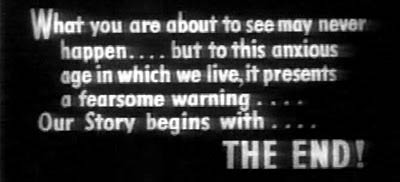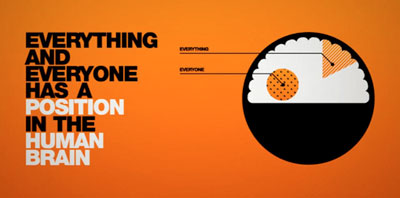science

Will booze make you skinny? (…)
Best case scenario is the study has indeed accounted for all variables and the association is causal and if you’re a woman, drinking 2 glasses of wine daily will help you not gain roughly a third of a pound extra per year.
Worse case scenario? The study proves just how difficult it is to study nutritional variables and that it’s one of those association doesn’t prove causality pieces.
{ Weighty Matters | Continue reading | unsourced photo }
food, drinks, restaurants, health, ideas, science | March 11th, 2010 4:46 pm

Scientists have spent the past decade making great strides in the field of brain-computer interfaces (BCI). By attaching a series of electrodes to a human brain, researchers can feed neural impulses from the brain into a computer to allow the direct control of robotic devices. One major downside, of course, is that the electrodes through which the subject controls these robotic devices have to be placed directly on the brain. This drawback had been in large part considered unavoidable, as electrodes placed outside the skull were thought to gather insufficient information to successfully operate a mechanical device. But in a study published last week in The Journal of Neuroscience, researchers were able to use an array of 34 electrodes attached to test-subjects’ scalps to deduce the subjects’ 3-dimensional hand movements. The importance of this work is clear: It may help patients who have lost a limb to operate a replacement robotic prostheses with their brain.
{ Seed | Continue reading }
related { Brain-Computer Interface Live demonstration of a brain-controlled Adams Family pinball machine | video }
brain, technology | March 11th, 2010 4:46 pm
climate, future, photogs | March 11th, 2010 4:46 pm

{ Why do we believe, and are atheists really more intelligent? | Artwork: Andrea Mantegna, Lamentation Over the Dead Christ, 1470-75 }
beaux-arts, psychology | March 11th, 2010 4:44 pm

How to rate the sportsmen and women of the day against the stars of yesteryear.
There’s no easy way to make meaningful comparisons when sports change so dramatically over the years. Even in endeavours like baseball where player stats have been meticulously kept for almost a hundred years, comparisons across the decades can be odious. Is it really fair to compare players from the 1920s against those of the last 20 years when so many external factors have changed such as the use of new equipment, better training methods and, of course, performance enhancing drugs?
In 1914, the National League Most Valuable Player was Johnny Evers with a batting average of 0.279, 1 Home Run and 40 Runs Batted In. That was impressive then but these stats would embarrass even a second rate player in today’s game.
But what if there were a way to remove the systematic differences to reveal intrinsic talent? Today, Alexander Petersen at Boston University and a few pals explain just such a method that “detrends” the data leaving an objective measure of a player’s raw ability.
{ The Physics arXiv Blog | Continue reading }
flashback, science, sport | March 11th, 2010 4:42 pm

In labs around the world, scientists are working to expand our understanding of the weird, the unexpected, and the potentially dangerous. Their aim is true, yet, many of these boundary-pushing projects carry serious potential for things to go wrong. Horribly wrong.
1. Scientists are trying to develop pure-fusion reactions—bursts that don’t require uranium or plutonium to ignite—for clean energy. But they could also usher in so-called low-yield nuclear weapons that emit very little radiation and could be both small and difficult to detect. (…)
2. Rovers and probes have provided some info on Martian soil and climate, but scientists want to bring a chunk of the Red Planet down to Earth on what’s called a sample-return mission. Uh, remember The Andromeda Strain? What happens if some freaky virus comes back on NASA’s planned 2018 sample return?
{ PopSci | Continue reading }
photo { Juergen Teller }
related { From the optimistic Adbusters: We stand on the cusp of one of humanity’s most dangerous moment. }
science, uh oh | March 4th, 2010 6:26 pm

A foreign language can sound so unintelligible that it’s hard to believe what linguists have been saying for years: Languages from around the world all follow the same rules. No language will ever require placing a particular word at a fixed point in a sentence (e.g., “da” must always be in the fifth position). No language forms questions by simply reversing the words in a statement. The reasons for this lie in the brain’s wiring, which dictates the possible patterns languages can follow. Anything that breaks the mold will be impossible to learn or pass down to a new generation.
Similarly, biologists say there are limits to what forms of life can possibly exist, because all new species must evolve from existing genetic material and because the external environment places constraints on which variations survive.
If evolution limits what creatures can look like and neurobiology dictates how languages work, perhaps our genes constrain the range of possible human cultures. “Some cultural forms will never be considered. … These can be thought of as impossible cultures,” writes Marc D. Hauser, a professor of psychology and human evolutionary biology at Harvard.
{ The Wilson Quarterly | Continue reading }
artwork { Ana Bagayan }
Linguistics, future, genes | March 4th, 2010 6:24 pm

The perception and recognition of faces is crucial for the social situations we encounter every day. From the moment we are born, we prefer looking at faces than at inanimate objects, because the brain is geared to perceive them, and has specialized mechanisms for doing so. Such is the importance of the face to everyday life, that we see faces everywhere, even when they are not there.
We know that the ability to recognize faces varies among individuals. Some people are born with prosopagnosia, the inability to recognize faces, and others acquire the condition as a result of brain damage. At the other end of the scale are people who never forget a face - the so-called “super-recognizers”. Two independent studies published recently now provide strong evidence that the ability to recognize faces is largely inherited, and that it is passed on independently from intelligence and other cognitive functions.
{ Neurophilosophy/ScienceBlogs | Continue reading }
photo { Diane Arbus, NYC, 1960 }
eyes, genes, science | March 4th, 2010 6:24 pm

Information theory is a branch of applied mathematics and electrical engineering involving the quantification of information. (…)
A key measure of information in the theory is known as entropy, which is usually expressed by the average number of bits needed for storage or communication. Intuitively, entropy quantifies the uncertainty involved when encountering a random variable. For example, a fair coin flip (2 equally likely outcomes) will have less entropy than a roll of a die (6 equally likely outcomes).
{ Wikipedia | Continue reading }
Claude Elwood Shannon (1916 – 2001), an American electronic engineer and mathematician, is known as “the father of information theory.”
Shannon is famous for having founded information theory with one landmark paper published in 1948. But he is also credited with founding both digital computer and digital circuit design theory in 1937, when, as a 21-year-old master’s student at MIT, he wrote a thesis demonstrating that electrical application of Boolean algebra could construct and resolve any logical, numerical relationship. It has been claimed that this was the most important master’s thesis of all time. (…)
The Las Vegas connection: Information theory and its applications to game theory
Shannon and his wife Betty also used to go on weekends to Las Vegas with M.I.T. mathematician Ed Thorp, and made very successful forays in blackjack using game theory type methods co-developed with physicist John L. Kelly Jr. based on principles of information theory. They made a fortune, as detailed in the book Fortune’s Formula. (…)
Shannon and Thorp also applied the same theory, later known as the Kelly criterion, to the stock market with even better results.
{ Wikipedia | Continue reading | Mathematical Theory of Claude Shannon, A study of the style and context of his work up to the genesis of information theory. | PDF }
recto/verso { Welcome to Fabulous Las Vegas sign, 1959, designed by Betty Willis. | In hopes that the design would be used freely, Willis never copyrighted her sign’s design. | PBS | Continue reading | More Betty Willis | NY Times | Photos: The Neon Museum, Las Vegas }
mathematics, technology, theory, vegas | March 4th, 2010 6:23 pm

The mathematics that describe both sensory perception and the transmission of information turn out to have remarkable similarities.
In 1834, the German physiologist Ernst Weber carried out a series of experiments to determine the limits of sensory perception. He gave a blindfolded man a mass to hold and gradually increased its weight, asking the subject to indicate when he first became aware of the change.
These experiments showed that the smallest increase in weight that a human can perceive is proportional to the initial weight. The German psychologist Gustav Fechner later interpreted Weber’s work as a way of measuring the relationship between the physical magnitude of a stimulus and its perceived intensity.
The resultant mathematical model of this process is called the Weber-Fechner law and shows that the relationship between the stimulus and perception is logarithmic. The Weber-Fechner law is important because it established a new field of study called psychophysics. (…)
The logarithmic relationship between a stimulus and its perception crops up in various well known examples such as the logarithmic decibel scale for measuring sound intensity and a similar logarithmic scale for measuring the visible brightness of stars, their magnitude.
Today, Hi Jun Choe, a mathematician at Yonsei University in South Korea, says there is an interesting connection between the Weber-Fechner Law and the famous mathematical theory of information developed by Claude Shannon at Bell Labs in the 1940s.
Shannon’s work is among the most important of the 20th century. It establishes the limits on the amount of information that can be sent from one location in the universe to another. It is no exaggeration to say that the world’s entire computing and communications infrastructure is based on Shannon’s work. (…)
Of course, the idea that sensory perception is a form of communication and so obeys the same rules, is not entirely surprising. What’s astonishing (if true) is that the connection has never been noticed before.
{ The Physics arXiv Blog | Continue reading }
mathematics, science, technology | March 4th, 2010 6:22 pm

Mirage: The Omnidroid 9000 is a top-secret military fighting robot. Artificial intelligence allows it to solve any problem it’s presented with, and, unfortunately…
Mr. Incredible: Let me guess. It became smart enough to wonder why it had to take orders.
Mirage: We lost control, and now it’s loose in the jungle, threatening our facility.
{ The Incredibles, 2004 }
Dave: Open the pod bay doors, HAL.
HAL: I’m sorry, Dave. I’m afraid I can’t do that.
Dave: What’s the problem?
HAL: I think you know what the problem is just as well as I do.
Dave: I don’t know what you’re talking about, HAL.
HAL: I know that you and Frank were planning to disconnect me, and I’m afraid that’s something I cannot allow to happen.
{ 2001: A Space Odyssey, 1968 }
future, haha, incidents, robots & ai, showbiz, space | March 4th, 2010 6:20 pm

The theory of relativity showed us that time and space are intertwined. To which our smarty-pants body might well reply: Tell me something I didn’t already know, Einstein.
Researchers at the University of Aberdeen found that when people were asked to engage in a bit of mental time travel, and to recall past events or imagine future ones, participants’ bodies subliminally acted out the metaphors embedded in how we commonly conceptualized the flow of time. (…)
The new study, published in January in the journal Psychological Science, is part of the immensely popular field called embodied cognition, the idea that the brain is not the only part of us with a mind of its own.
{ Natalie Angier/NY Times | Continue reading }
ideas, science, time | March 4th, 2010 6:16 pm
Botany, visual design | March 4th, 2010 6:14 pm

Over the past quarter century, DNA evidence has transformed criminal justice, freeing hundreds of innocent people and helping unravel countless crimes that might otherwise have gone unsolved. It has also captivated the public imagination: the plots of popular TV crime shows often hinge on the power of DNA to crack impossible cases, which has helped to give this forensic tool an air of infallibility—a phenomenon known in criminal justice circles as “the CSI effect.” This failsafe image is not entirely unfounded, especially when it comes to traditional applications of DNA evidence.
But increasingly DNA is being used for a new purpose: to target the culprits in cold cases, where other investigative options have been exhausted. All told, U.S. law enforcement agencies have conducted more than 100,000 so-called cold-hit investigations using the federal DNA database and its state-level counterparts, which hold upward of 7.6 million offender profiles. In these instances, where the DNA is often incomplete or degraded and there are few other clues to go on, the reliability of DNA evidence plummets—a fact that jurors weighing such cases are almost never told. As a result, DNA, a tool renowned for exonerating the innocent, may actually be putting a growing number of them behind bars.
{ Washington Monthly | Continue reading }
U.S., genes, incidents | March 4th, 2010 6:12 pm

Removal of specific parts of the brain can induce increases in a personality trait which predisposes people to spirituality, according to a new clinical study by Italian researchers. The new research, published earlier this month in the journal Neuron, provides evidence that some brain structures are associated with spiritual thinking and feelings, and hints at individual differences that might make some people more prone than others to spirituality.
{ Neurophilosophy/ScienceBlogs | Continue reading }
brain | March 4th, 2010 6:10 pm

Australia’s vile and poisonous plague of cane toads may finally have met its match — and it comes in a tin of cat food.
After years spent trying to batter, gas, run over and even freeze the toxic toads out of existence, scientists say just a dollop of Whiskas could stop the warty horde.
The cat food attracts Australia’s carnivorous meat ants, which swarm over and munch on baby toads killing 70 percent of them.
{ AFP/Physorg | Continue reading }
The most poisonous animal substance is batrachotoxin, produced by the poison arrow frog of South America. As little as the weight of two grains of table salt will turn your lights out for good.
{ What’s the fastest-acting, most lethal poison? | The Straight Dope | Continue reading }
amphibian, poison, science | March 4th, 2010 6:00 pm

Paradoxically we initially like narcissists more because of their exploitative, entitled behaviour—but it doesn’t last long. (…)
There are all sorts of paradoxes in the way narcissists behave. Here are three that this research helps explain:
1. Why do people continue to behave selfishly when it only ruins their relationships with others?
2. Why do narcissists devalue others when they are so dependent on them for admiration?
3. Why don’t narcissists spot the cycle of early attraction followed by rejection?
The first two are partly explained by the fact that narcissistic behaviour is, at first, attractive to other people. Behaving selfishly seems to bring them a rush of admiration which they get addicted to, while devaluing others when the inevitable rejection comes, covering it up by searching out new people to worship them.
The reason narcissists fail to spot this cycle may well be that friends and partners never hang around long enough to tell them in such a way that they actually believe it and want to do something about it.
{ PsyBlog | Continue reading }
graphic design { Casper Sormani }
psychology, weirdos | March 4th, 2010 6:00 pm

Scientists have proposed that the way food smells could possibly be related to the sounds we hear when we consume them.
They note that there could be a connection between smell and sound, a hybrid sense they call “smound.”
{ Discover | Continue reading }
artwork { Yves Klein, F 88, 1961 }
Linguistics, art, science | March 4th, 2010 9:10 am

Women are up to nine times more likely to suffer from cold hands and feet than men, I read last week. We feel changes in temperature and the seasonal chill more. Did this surprise me? Not a bit . (…)
There are many theories as to why women suffer from this problem. Women have more evenly distributed fat layers, providing internal insulation. But while the result is that our blood supply favours protecting our core organs and trunk over our extremities, it means less blood flows to the hands and feet.
Men on the other hand have more heat-generating muscle mass, better supplied by blood vessels, increasing blood flow and, therefore, warmth.
Foot expert Margaret Dabbs says another reason why women’s feet in particular get colder than men’s is because our skin is thinner. (…)
Avoid alcohol or caffeine as both increase blood flow to the skin, so while you might feel warmer, your body is losing heat. (…)
Mood can influence our temperature - people who are lonely or socially excluded feel the cold more.
{ Daily Mail | Continue reading }
guide, health, science, temperature | March 4th, 2010 8:15 am

Network theory: A key to unraveling how Nature works
In the last two decades, network theory has emerged as a way of making sense of everything from the World Wide Web to the human brain. Now, as ecologists have begun applying this theory to ecosystems, they are gaining insights into how species are interconnected and how to foster biodiversity.
{ Carl Zimmer | Continue reading }
photo { David Lachapelle, Pamela Anderson, Secret Garden, 2001 }
science | March 4th, 2010 8:11 am






















